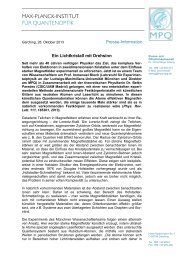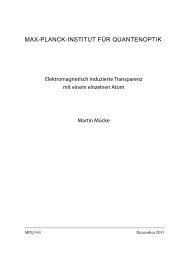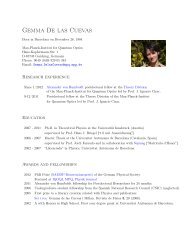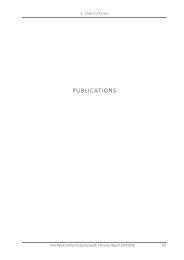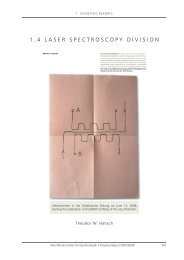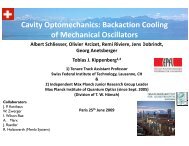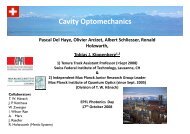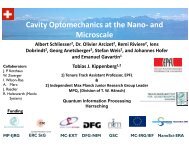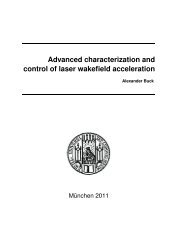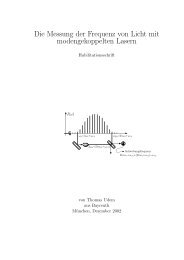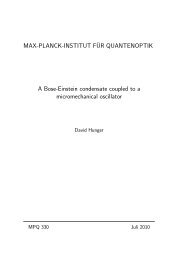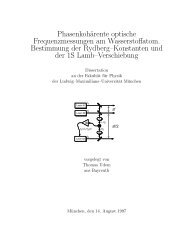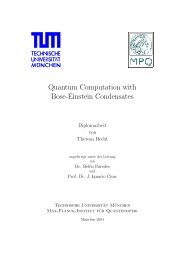Attosecond Control and Measurement: Lightwave Electronics
Attosecond Control and Measurement: Lightwave Electronics
Attosecond Control and Measurement: Lightwave Electronics
You also want an ePaper? Increase the reach of your titles
YUMPU automatically turns print PDFs into web optimized ePapers that Google loves.
1 . 3 AT T O S E C O N D A N D H I G H - F I E L D P H Y S I C S D I V I S I O N<br />
ARTICLES NATURE |Vol 446 | 5 April 2007<br />
via Auger decay is accompanied by transitions to unoccupied orbitals<br />
via ‘shake-up’ (Fig. 2d–f) 14–16 . Here, we use the term ‘shake-up’ in a<br />
broad sense, st<strong>and</strong>ing for all possible processes populating excited<br />
ionic states (including instantaneous <strong>and</strong> non-instantaneous ones),<br />
henceforth referred to as shake-up states (represented by levels 1, 2<br />
<strong>and</strong> 3 in the example of Fig. 2). These populations can be probed via<br />
optical field ionization by a strong, few-cycle NIR pulse of variable<br />
delay Dt, with respect to the subfemtosecond XUV excitation (Fig. 1c)<br />
by measuring the number of ions resulting from the XUV pump–NIR<br />
probe exposure as a function of Dt (Fig. 1d).<br />
Shake-up usually populates several quantum states in the valence<br />
b<strong>and</strong>, from which electrons can be freed by the NIR probe. Hence, the<br />
ion yield will constitute an integral signal, with contributions from all<br />
shake-up states up to a certain binding energy from which ionization<br />
is feasible for the intensity chosen. Population dynamics of individual<br />
states of significantly differing binding energy can be retrieved by<br />
pump–probe scans repeated at different NIR probe intensities <strong>and</strong>/<br />
or from the temporal separation of the depletion of the states in the<br />
same delay scan, as explained in Fig. 1d <strong>and</strong> demonstrated in Fig. 4.<br />
The ion yield constitutes an integral signal in a temporal sense, too.<br />
The shake-up states are exposed to the ionizing NIR field from the<br />
moment they have been populated until the end of the NIR pulse. The<br />
a<br />
W<br />
b<br />
0<br />
–W b<br />
Ionization<br />
rate<br />
e –<br />
0 x<br />
Core<br />
Time<br />
c<br />
XUV<br />
pump<br />
∆t (> 0)<br />
E L (t)=E 0 ε(t)cos(ω L t+ϕ)<br />
d<br />
Ionization<br />
yield<br />
T L /2<br />
Depletion of states<br />
with binding energy<br />
W 1 <strong>and</strong> W 2<br />
Delay time, ∆t<br />
beginning of this time interval within the NIR pulse is adjusted with<br />
the delay Dt between the XUV pump <strong>and</strong> the NIR probe. As the delay<br />
is scanned from large negative values (NIR probe first) to large positive<br />
values (XUV pump first) the measured ion yield (Fig. 1d) starts<br />
increasing at Dt , 0 owing to ionization on the trailing edge of the<br />
NIR pulse <strong>and</strong> continues to increase with increasing Dt because the<br />
XUV pump shifts towards the peak of the ionizing NIR probe <strong>and</strong> the<br />
shake-up states are exposed to ever higher NIR probe intensities.<br />
In the absence of Auger decay, shake-up excitation results from<br />
photoionization only (Fig. 2d). The time-dependent ionization<br />
dynamics sketched in Fig. 1d can then be traced by measuring the<br />
yield of doubly charged ions as a function of the delay between the<br />
XUV pump <strong>and</strong> the sampling NIR light field. The temporal ionization<br />
gradients sketched in Fig. 1d incorporate the finite duration of<br />
the XUV excitation, a possible delayed response of shake-up <strong>and</strong> the<br />
tunnelling dynamics. With a sufficiently rapid (=1 fs) excitation,<br />
these measurements can thus provide direct insight into the temporal<br />
evolution of shake-up (in the presence of a strong optical field) <strong>and</strong><br />
light-induced tunnelling. In what follows, first we prove this concept<br />
by exposing neon atoms to our subfemtosecond XUV pump <strong>and</strong> fewcycle<br />
NIR probe pulses (Fig. 3) <strong>and</strong> measuring the yield of the product<br />
of the pump–probe exposure, Ne 21 , versus Dt (Fig. 4). Then we<br />
extend the approach to probing electrons shaken up in xenon atoms<br />
during Auger decay. Our primary observables in this case are higher<br />
charged states, Xe N1 (for N . 2). Measuring their yield versus Dt<br />
displays the course of an Auger cascade.<br />
166 Max-Planck-Institut für Quantenoptik • Progress Report 2007/2008<br />
NIR<br />
probe<br />
Figure 1 | Strong-field ionization <strong>and</strong> pump-probe setting for its real-time<br />
observation. a, Exposing an atom to a strong NIR laser field will result in a<br />
modified potential (solid curve) composed of the Coulomb potential<br />
(dashed curve) <strong>and</strong> the time-dependent effective potential of the laser pulse.<br />
The laser is polarized along the x direction <strong>and</strong> W b is the binding energy of<br />
the electron. At sufficiently high laser field strengths the atomic binding<br />
potential is suppressed to a small barrier in the x or –x direction for the<br />
maxima <strong>and</strong> minima of the laser electric field, respectively, allowing optical<br />
tunnelling to become the dominant ionization mechanism. b, The highly<br />
nonlinear dependence of the tunnelling rate on the width of the potential<br />
barrier confines ionization to time intervals of very short duration near the<br />
field oscillation maxima. In the electric field of a few-cycle NIR laser pulse<br />
(thin line) ionization is predicted to be restricted to several subfemtosecond<br />
intervals (thick line). c, Concept for tracing optical-field ionization: a<br />
subfemtosecond XUV pulse generates ions in excited (shake-up) states, from<br />
which a time-delayed NIR few-cycle probe pulse liberates electrons to<br />
produce doubly charged ions. A delay Dt 5 0 is defined as the coincidence of<br />
the peaks of the envelopes of the NIR <strong>and</strong> XUV pulse. Dt . 0 implies that the<br />
peak of the XUV pulse envelope precedes that of the NIR pulse. d, Yield of<br />
doubly charged ions versus delay Dt between the XUV pump <strong>and</strong> the NIR<br />
probe, as predicted qualitatively for the case of electrons being prepared in<br />
two shake-up states of significantly differing binding energy (W 1 <strong>and</strong><br />
W 2 ? W 1) for liberation via strong-field ionization (see text for discussion).<br />
The state of low binding energy is depleted at low intensities, where multiphoton<br />
ionization dominates <strong>and</strong> hence sub-cycle structure in the ionization<br />
dynamics is absent. By contrast, the state of high binding energy is emptied<br />
by tunnelling, resulting in pronounced sub-half-cycle steps in the ionization<br />
profile.<br />
628<br />
Kinetic energy<br />
0<br />
Binding energy<br />
©2007 Nature Publishing Group<br />
+1 +1<br />
Valence Core-level<br />
photophotoemissionemission Probing by attosecond<br />
Streaking<br />
+2<br />
Auger<br />
decay<br />
1<br />
2<br />
+1 +1<br />
Tunnelling<br />
Photo-emission<br />
<strong>and</strong> shake-up<br />
a b c d e f<br />
3<br />
Unoccupied<br />
valence<br />
Occupied<br />
valence<br />
Core<br />
orbital<br />
+2 Final<br />
Auger charge<br />
decay <strong>and</strong> state<br />
shake-up<br />
Figure 2 | Probing electron dynamics in atoms, molecules or solids with<br />
attosecond sampling techniques. A subfemtosecond XUV pulse triggers the<br />
motion by inducing valence (process a) or core photoelectron emission<br />
(process b). The temporal evolution of photo- <strong>and</strong> Auger electron emission<br />
(process c) can be probed via attosecond streaking to retrieve the XUV pump<br />
pulse or the sampling NIR field <strong>and</strong> trace inner-shell relaxation dynamics.<br />
XUV photoexcitation as well as subsequent Auger decay processes are<br />
usually accompanied by shake-up of another electron to a previously<br />
unoccupied level (processes d, e <strong>and</strong> f). In this case the liberated electrons<br />
will be ejected at a reduced kinetic energy compared to the cases without<br />
shake-up processes a, b <strong>and</strong> c. The difference in energy is used for shaking up<br />
bound electrons (represented by curved black arrows to levels 1, 2 <strong>and</strong> 3).<br />
For sufficiently strong probing laser fields, the shake-up electrons can be<br />
liberated by tunnelling ionization. The temporal evolution of the tunnelling<br />
current will provide information about the inner-atomic electron dynamics<br />
that populates <strong>and</strong>/or depopulates the interrogated shake-up states <strong>and</strong> the<br />
duration of the process that have populated the levels on atto- <strong>and</strong><br />
femtosecond timescales. Note that the final charge state given in the figure is<br />
increased by attosecond tunnelling, while it remains unchanged in the case<br />
of attosecond streaking. The observable for streaking is the momentum<br />
distribution of liberated electrons, whereas in tunnelling it is the number of<br />
ions in different charge states.



